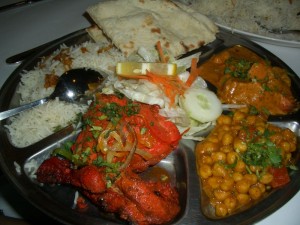 All around us we find tons of books, websites, and other information about food and nutrition. What we should eat and what not, what foods to avoid for diabetes, what foods to eat to lower cholesterol and what foods to avoid for weight loss. Zillions of nutritionists, dietitians, physicians, nurses, body builders and quacks have made millions writing such books. Most of these books, however, cater to the western food habits. Their meal suggestions, recipes and nutritional information cover only the kind of diet that we Indians hardly eat in our daily lives. Some diet books lightly touch upon some of the Indian foods but they are severely limited to the typical north Indian recipes like tandoori chicken or chicken tikka masala. But if you are a Bengali, then CTM (as they call chicken tikka masala in UK) appears rarely on our diet. We would be interested in knowing whether chhaanar dalna is a healthier meal than shorshe ilish.
All around us we find tons of books, websites, and other information about food and nutrition. What we should eat and what not, what foods to avoid for diabetes, what foods to eat to lower cholesterol and what foods to avoid for weight loss. Zillions of nutritionists, dietitians, physicians, nurses, body builders and quacks have made millions writing such books. Most of these books, however, cater to the western food habits. Their meal suggestions, recipes and nutritional information cover only the kind of diet that we Indians hardly eat in our daily lives. Some diet books lightly touch upon some of the Indian foods but they are severely limited to the typical north Indian recipes like tandoori chicken or chicken tikka masala. But if you are a Bengali, then CTM (as they call chicken tikka masala in UK) appears rarely on our diet. We would be interested in knowing whether chhaanar dalna is a healthier meal than shorshe ilish.
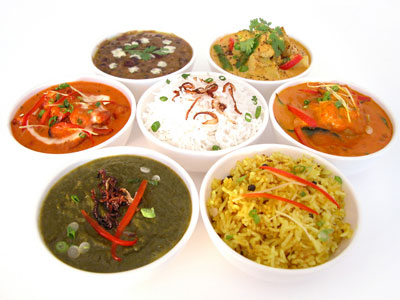 Few months ago, a friend of mine forwarded me an e-book (a pdf file) titled “Indian Foods: AAPI’s Guide to Health, Nutrition, and Diabetes”. This book, written by a team of experts appointed by the American Association of Physicians of Indian Origin (AAPI) provides an invaluable guide to the Indians living in America to make some sense of their diet in terms of healthiness. The best part of this book is that it contains chapters pertaining to the regional foods of India. For example, in its chapter on Bengali and Oriya cuisine, the author provides a table (no pun intended) showing a typical Bengali diet and how it can be modified to make it healthier.
Few months ago, a friend of mine forwarded me an e-book (a pdf file) titled “Indian Foods: AAPI’s Guide to Health, Nutrition, and Diabetes”. This book, written by a team of experts appointed by the American Association of Physicians of Indian Origin (AAPI) provides an invaluable guide to the Indians living in America to make some sense of their diet in terms of healthiness. The best part of this book is that it contains chapters pertaining to the regional foods of India. For example, in its chapter on Bengali and Oriya cuisine, the author provides a table (no pun intended) showing a typical Bengali diet and how it can be modified to make it healthier.
I’d like to welcome you all to download this book by clicking on this link. AAPI is distributing this book for free. I thank AAPI for providing this valuable resource.
Category Archives: Generic
Cartoon of the Week 6: The Pujo Entertainment
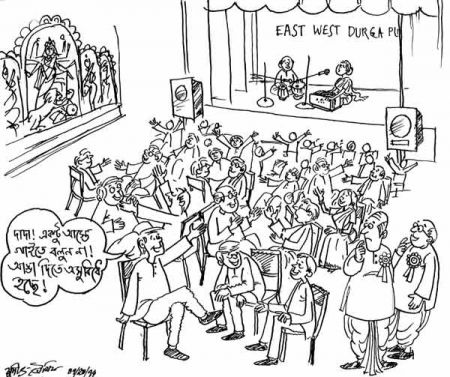 Entertainment events are the major attractions of any Durga Puja festival. The Puja organizers spend thousands of dollars to get the most popular artistes from India as well as from the local talent pool. It is the star entertainers that pull in the crowd, and crowd brings in revenue. The popularity ratings of the entertainers define the success of a Durga Puja.
Entertainment events are the major attractions of any Durga Puja festival. The Puja organizers spend thousands of dollars to get the most popular artistes from India as well as from the local talent pool. It is the star entertainers that pull in the crowd, and crowd brings in revenue. The popularity ratings of the entertainers define the success of a Durga Puja.
But is it true? If the stars and their entertainment was the only reason to attend a Puja festival, then why do we have to listen to the constant rumbling noise of numerous “adda” sessions that continue in the background? As the audio levels of the performers rise, so does the noise level. To many attendees (myself included) the main attraction of attending a Puja is the opportunity to meet friends and engage in endless “addas”. We have no ill feeling towards the performers, they can continue to do their job as long as they don’t disturb our “addas”. After all, it is them who made us decide which Puja to attend – but they cannot deny us our birth right to be able to talk, talk and talk for hours on. We will occasionally listen to one or two songs to give our tired jaw bones some rest, but soon we’ll get back to argue about who was the best performer of the song, and how this “hopeless” artist has ruined the song completely. We’ll lament the dearth of talent in Bengal and how we miss the golden days of Kishore and Hemanta-da, how the new generation of band music is destroying Bangla music and why one should ban artistes like Sumon and Nachiketa.
ECTA Looking for Actors and Actresses
ECTA (Ethnomedia Center for Theater Arts) is looking for actors and actresses for their upcoming production to be staged in late November 2008. Previous acting experience is nice to have but not necessary. Love for theater and performing arts is a must.
If you are interested please attend the following casting call.
Play: Banaprastha – a play in Bengali by Sudipta Bhawmik
Directed by: Indranil MukherjeeDate and Time: Friday Sept 5 at 7:30pm
Place: 28 McBride Way, Bridgewater, NJ 08807To RSVP send email to indymukh@gmail.com or bhawmik@gmail.com
Cartoon of the Week 5: Pujo Cartoon
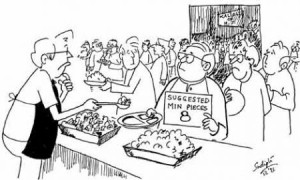 Durga Puja festival has always been a great source of inspiration to me as a cartoonist. I have drawn several cartoons related to this festival and the way we celebrate it in our adopted homeland. Last week I posted one on the “Chanda” issue. This cartoon (drawn a long time ago for Kallol Sahityo Patrika) also takes a spin on the same touchy subject. In earlier times (late 80’s and early 90’s), the Pujo organizers did not specify or “suggest” any contribution amount to the attendees. The strong “suggestion” became, sort of, necessary from the later half of the 90’s when goat meat (or mutton curry) became a must item at the Saturday evening community dinner. Goat meat has always been an expensive item, and with the unpredictable attendance being a major problem, estimating the amount of meat to be cooked is always an issue. The volunteers serving dinner had to deploy smart strategies to control the number of mutton pieces to the hungry devotees standing in the line. At the beginning phase, they are generally generous, especially to their friends and families. However, soon (after a quick review by the supervisors) the strategy changes to a rationing mode when the number of mutton pieces served becomes indirectly proportional to the number of attendees. Now in this situation, the tired and hungry attendee, who has paid the “suggested minimum contribution” has all the right to demand a “suggested minimum number of pieces” of the precious goat meat. After all, that was one of the key factors that attracted him to this festival in the first place!
Durga Puja festival has always been a great source of inspiration to me as a cartoonist. I have drawn several cartoons related to this festival and the way we celebrate it in our adopted homeland. Last week I posted one on the “Chanda” issue. This cartoon (drawn a long time ago for Kallol Sahityo Patrika) also takes a spin on the same touchy subject. In earlier times (late 80’s and early 90’s), the Pujo organizers did not specify or “suggest” any contribution amount to the attendees. The strong “suggestion” became, sort of, necessary from the later half of the 90’s when goat meat (or mutton curry) became a must item at the Saturday evening community dinner. Goat meat has always been an expensive item, and with the unpredictable attendance being a major problem, estimating the amount of meat to be cooked is always an issue. The volunteers serving dinner had to deploy smart strategies to control the number of mutton pieces to the hungry devotees standing in the line. At the beginning phase, they are generally generous, especially to their friends and families. However, soon (after a quick review by the supervisors) the strategy changes to a rationing mode when the number of mutton pieces served becomes indirectly proportional to the number of attendees. Now in this situation, the tired and hungry attendee, who has paid the “suggested minimum contribution” has all the right to demand a “suggested minimum number of pieces” of the precious goat meat. After all, that was one of the key factors that attracted him to this festival in the first place!
Cartoon of the Week 4: Pujor Chanda
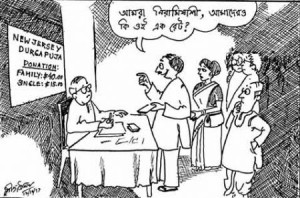 Pujo contribution or Chaanda (as we fondly call this concept) is always an issue with the average Bengali. Be it in India or in USA, Bengalis have the feeling that this is an unjust extortion in the name of a festival that we all like to attend. It should be free for all of us. Where the organizers get their funds is not for us to bother about. Since, most of the Pujo organizers make it a point to ensure that each and every attendee pays their contribution, we’d like to get away with the minimum amount that helps us to claim a stake in the festival. But the Pujo organizers these days are smart, they make the contribution amount quite obvious by displaying it in bold font. To justify the specified amount, the organizers will cite different components of the cost incurred to hold a festival of this magnitude, like goat meat, Mumbai and Kolkata performers – etc etc. This cartoon raises a legitimate question – why not an a-la carte system for Pujor Chanda? Sounds fair to me!
Pujo contribution or Chaanda (as we fondly call this concept) is always an issue with the average Bengali. Be it in India or in USA, Bengalis have the feeling that this is an unjust extortion in the name of a festival that we all like to attend. It should be free for all of us. Where the organizers get their funds is not for us to bother about. Since, most of the Pujo organizers make it a point to ensure that each and every attendee pays their contribution, we’d like to get away with the minimum amount that helps us to claim a stake in the festival. But the Pujo organizers these days are smart, they make the contribution amount quite obvious by displaying it in bold font. To justify the specified amount, the organizers will cite different components of the cost incurred to hold a festival of this magnitude, like goat meat, Mumbai and Kolkata performers – etc etc. This cartoon raises a legitimate question – why not an a-la carte system for Pujor Chanda? Sounds fair to me!
New Jersey Durga Puja 2008
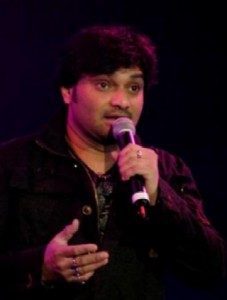 The most awaited event for any Bengali, the Durga Puja festival, is less than two months away. Kallol of NJ will be celebrating this festival during the weekend of October 3 to 5, 2008, while Garden State Cultural Association will have a concurrent celebration on Oct 4th and 5th. Having a concurrent celebration has its pros and cons. On the positive side, it helps to divide the audience which otherwise becomes impossible to manage at a single venue. The negative aspect is that many of us, who would have loved to attend both (and attend them completely), are denied of the opportunity.
The most awaited event for any Bengali, the Durga Puja festival, is less than two months away. Kallol of NJ will be celebrating this festival during the weekend of October 3 to 5, 2008, while Garden State Cultural Association will have a concurrent celebration on Oct 4th and 5th. Having a concurrent celebration has its pros and cons. On the positive side, it helps to divide the audience which otherwise becomes impossible to manage at a single venue. The negative aspect is that many of us, who would have loved to attend both (and attend them completely), are denied of the opportunity.
However, even this joint celebration (I mean the dates only) is not helping the organizers. Depending on what performers are being invited from Kolkata or Mumbai by these organizers, crowd management becomes a major issue with frequent interruptions and threats from the Fire dept. Inviting these famous artists to perform during the Puja is a double edged sword. You need to get the popular star performers to pull in the crowd because it is them who pays for the enormous expense. On the other hand, too many people cannot be accommodated in the spaces the organizers typically use. Continue reading
Sahitya O Alochana @ Ananda Mandir
Ananda Mandir is starting a regular Sahitya O Alochana – Meeting of literary readings and discussionswith a meeting this Friday, 22 August 2008, at 8:30 PM.
The aim is to have a quasi-monthly meeting of literary readings and discussions, occasionally interspersed with lectures on religion or philosophy. The first meeting will focus on how to get the effort organized, but we will also have invited speakers from our community speaking on selected topics. Anyone interested is welcome to attend.
Cartoon of the Week 3: The Selection Process
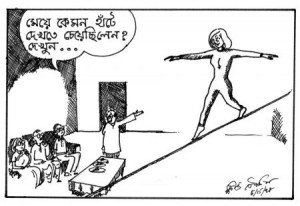 Arranged marriage is still quite common in India, and one important phase in an arranged marriage is the process of selecting the bride. Mind you, I said “bride selection” and not “groom selection”. An important component of this process is to visit the bride’s home and conduct an interview of the girl to figure out if the girl is a suitable candidate. In some cases, the girl is not only asked to provide verbal answers to the questions, but also demonstrate their gait, posture, length of the hair and also their artistic, musical, and culinary skills. This cartoon was drawn to emphasize on this aspect of the selection process – the girl demonstrates her gait by walking on a tight rope. After all, that’s what she will have to do everyday at her in-laws family – walk the fine line with amazing dexterity, balance and skill. Women of our country may not be participating at the Olympics gymnastics events, but this skill of walking the horizontal beam is in their genes. This cartoon was done for Proma (published from Kolkata) few years ago. I thought this would be an interesting post during this Olympic season.
Arranged marriage is still quite common in India, and one important phase in an arranged marriage is the process of selecting the bride. Mind you, I said “bride selection” and not “groom selection”. An important component of this process is to visit the bride’s home and conduct an interview of the girl to figure out if the girl is a suitable candidate. In some cases, the girl is not only asked to provide verbal answers to the questions, but also demonstrate their gait, posture, length of the hair and also their artistic, musical, and culinary skills. This cartoon was drawn to emphasize on this aspect of the selection process – the girl demonstrates her gait by walking on a tight rope. After all, that’s what she will have to do everyday at her in-laws family – walk the fine line with amazing dexterity, balance and skill. Women of our country may not be participating at the Olympics gymnastics events, but this skill of walking the horizontal beam is in their genes. This cartoon was done for Proma (published from Kolkata) few years ago. I thought this would be an interesting post during this Olympic season.
Some Reviews on ECTA’s Theater Festival
Recently a bunch of reviews on ECTA’s mini Theater festival plays have been published in various news and online media both in USA and India. I would like to share them with you, since many may not have access to these publications, especially those which are published in India.
- Gautam Dutta wrote about “Satyameva…” in Sambad Bichitra (published by CAB). The review is in Bengali and to read it click here.
- Gayatri Gamarsh wrote about the second day of the festival in Ananda Sambad. Click here to read that review.
- Alolika Mukherjee’s detailed review appeared in Saptahik Bartaman in Kolkata. Click here to read it.
- Madhu Rye Thaker writes about Satyameva in India Abroad. Click here.
- Jyotirmoy Dutta writes about ECTA and Taconic Parkway in DesiTalk. Click Here.
- Sambit Basu writes about Taconic Parkway in his blog “Monk’s Pearl“.
The opinions expressed in these reviews are solely that of the reviewers themselves. They provide us with different perspectives, but they can never replace the actual viewing of the play and its enjoyment. Plays, films and any other objects of art should be viewed and appreciated on your own. To get an wonderful perspective on reviews, I recommend watching the fantastic animated film “Ratatouille” and listen to the final review by Anton Ego (Peter O’Toole) the dreaded food critic.
Lopamudra Concert in New Jersey
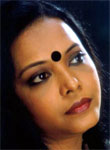 Few weeks ago, Lopamudra Mitra presented a concert at the Marlboro High School Auditorium at the invitation of the Dakshineshwar Ramkrishna Sangha Adyapeath (DRSA) of New Jersey. She was touring USA at the invitation of the Bangamela 2008 (held in Columbus OH) and before leaving the country, she made a brief visit to New Jersey. It was Lopamudra’s special attachment to Dakshineshwar Adyapeath that brought her to this fund raising concert. However, the audience response was only lukewarm at best. The torrential downpour before the concert may have contributed to the low attendance, but I think the major reason is the multiple events that are happening all around us during the summer season. Continue reading
Few weeks ago, Lopamudra Mitra presented a concert at the Marlboro High School Auditorium at the invitation of the Dakshineshwar Ramkrishna Sangha Adyapeath (DRSA) of New Jersey. She was touring USA at the invitation of the Bangamela 2008 (held in Columbus OH) and before leaving the country, she made a brief visit to New Jersey. It was Lopamudra’s special attachment to Dakshineshwar Adyapeath that brought her to this fund raising concert. However, the audience response was only lukewarm at best. The torrential downpour before the concert may have contributed to the low attendance, but I think the major reason is the multiple events that are happening all around us during the summer season. Continue reading
